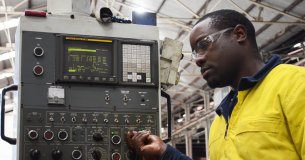-
Featured Items
-
Featured Resources
 Funding & Grants
Don't miss out on funding opportunities. Stay informed with our up to date online listings and email notifications.
Read More
Funding & Grants
Don't miss out on funding opportunities. Stay informed with our up to date online listings and email notifications.
Read More
 Skilled Migration
Our services help both applicants and employers, to learn more, develop plans, submit applications, and settle in.
Read More
Skilled Migration
Our services help both applicants and employers, to learn more, develop plans, submit applications, and settle in.
Read More
 Research and Analysis
Good research and analysis makes the case. How can our resources and services help your project or application?
Read More
Research and Analysis
Good research and analysis makes the case. How can our resources and services help your project or application?
Read More
 Information & Data Resources
With resources like REMPLAN, Regional Knowledge Base, and decades of data, discover how we can help your project.
Read More
Information & Data Resources
With resources like REMPLAN, Regional Knowledge Base, and decades of data, discover how we can help your project.
Read More
-
Stay InformedSubscribe to one or more of our regular email subscriptions, to be kept up to date on news and funding opportunities for the region
-
-
Our Region
- Our Region
- Regional Plan
- Regional Data
- Current Regional Issues
- Population Migration Analysis for 2016-21
- Job Vacancies Continue at All-Time High
- National Debt - What it Means for Our Economy?
- The True Value of Home Solar
- The Economic Impacts of Local Government Amalgamations
- State of the Regions Report 2014-15
- Antifragility - A different take on regional economic development
- Biohubs - Collaborative Waste Management
- Attracting New Residents
- Socio-Economic Impacts of the Murray Darling Basin Plan
- Murray Darling Basin Water Recovery
- Growing Businesses
- The Northern Inland Economy
- Geographical Overview
- Major Industry Sections
- Our Services
- Grants and Funding
-
Skilled Migration
- Skilled Migration
- Skilled Employer Sponsored Regional Visa
- Skilled Work Regional Visa (subclass 491)
- Temporary Seasonal Workers
- Designated Area Migration Agreement (DAMA)
- Helpful Information for Visa Holders
- Information for Employers
- Case Studies
- Payment Details
- Advice & Further Information
- Contact Details
- News & Events
-
Our Projects
- Our Projects
- Current Projects
- Skilled Migration
- Wool Works - Wool Training Schools
- Metal Works - Welding and Fabrication Schools
- Come On Inland
- Stories of Resilience
- Alt Brothers Beekeeping - Glen Innes
- Carelle's Toy Store - Glen Innes
- Greenhill Orchards - Arding
- Gwydir Meats - Warialda
- Kaputar Motors - Narrabri
- Moonbi General Store - Moonbi
- Sandstock - Tingha
- Sherelle Fashions - Tenterfield
- Sleepy Merino - Inverell
- Tenterfield Chamber of Toursim, Industry and Business - Tenterfeild
- The Welders Dog - Armidale
- Walcha Veterinary Supplies - Walcha
- AGCAP - Agribusiness Careers & Professions
- Northern Inland Regional Investment Profile
- Past Projects
- Digital Economy Strategy
- Business Growth Project
- Go Digital
- How to Start an Online Business
- Create Your Website Using Squarespace
- How to Edit Your Squarespace Site - Part 1
- How to Edit Your Squarespace Site Part 2
- Add a Shop to Your Squarespace Site
- Start a Blog and Find out What Customers are Searching
- 14 Tips For a Better Blog Post
- Which Social Media Platforms are Best for Your Business
- How to Use Facebook Effectively For Your Business – Part 1
- How to Use Facebook Effectively For Your Business – Part 2
- Instagram Tips for Business
- Catching Up, More Instagram & Dealing with Haters
- Getting Started with Twitter for Business
- Social Media Scheduling Tools
- How to Start an Etsy Shop – Part 1 – Research
- How to Start an Etsy Shop – Part 2 – Signup
- Online Security for Your Business
- Product Photography and Website Images: Your Guide
- 5 Tips to Improve your Productivity in your Business
- Best Online Business Resources
- How to Improve Your Communication Skills and Win More Clients
- NBN Coordinator
- Putting Power Back in the Regions
- Road Freight Study
- Town Audit Benchmarks
- Food and Wine
- Youth Survey
- Digital TV Switchover Assistance
- Northern Inland Transport Guide
- Live.Train.Work
- Northern Inland Innovation Awards
- Northern Inland Innovation Awards - 2017
- Northern Inland Innovation Awards - 2016
- Northern Inland Innovation Awards - 2015
- Northern Inland Innovation Awards - 2014
- Northern Inland Innovation Awards - 2013
- Northern Inland Innovation Awards - 2012
- Norther Inland Innovation Awards - 2011
- Prime Super Northern Inland Innovation Awards - 2010
- Prime Super Northern Inland Innovation Awards - 2009
- Northern Inland Innovation Awards - 2007
- Northern Lights Project
- NBN Smart Home
- Murray Darling Basin
- Moree Plains Business Workshops
- Namoi Investment Prospectus
- Industrial Land
- Bioenergy and Local Electricity Retailing
- Northern Inland Business Energy Assessment
- Skills for the Future
- Impacts of COVID-19 on Businesses
- Past Projects of NIRDB
- Aboriginal Employment and Enterprise in the Gunnedah Region
- Art as an Industry
- Aviation Survey
- Farm Forestry - Northern Inland Forestry Investment Group
- New England North West Film Strategy
- Northern Inland Excellence in Business Awards
- Food and Wine 2003 - 2008
- Prime Super Northern Inland Innovation Awards 2009
- Regional Business Networking Program
- Regional Leadership Course 2008
- Viticulture Strategy 2002-2003
- About Us
- Contact Us
- Other Resources
- Privacy and Legal
- Search
Skilled Employer Sponsored Regional Visa (SESR)
Visa Sub-class 494
The Skilled Employer Sponsored Regional (SESR) visa program allows employers in regional Australia to sponsor workers from overseas in order to fill skilled vacancies that cannot otherwise be filled. This important option for employers results in the visa sub-class 494 being granted by the Australian Department of Home Affairs if the skilled migrant and the employer are successful.
The 494 visa has a five year duration and requires that the sponsored migrant remain with the nominating employer for at least three years, to be eligible to apply for the 191 Permanent Residency (PR) visa.

It is recommended that employers read as much information about this visa program as possible to understand what is involved and what their obligations entail.
The 494 page on the Home Affairs website is a good resource. This is also where the application can be made to the Department.
Included Occupations
A sponsored occupation must be skilled. According to the Department of Home Affairs, skilled occupations are those classified as level 1, 2 or 3 in the Australian and New Zealand Standard Classification of Occupations (ANZSCO). This generally means occupations requiring a degree, diploma, trade certificate or certificate IV, however a minimum level of experience can be substituted for qualification in certain occupations (see the ANZSCO list online).
The Role of the Regional Certifying Body (RCB)
The Skilled Employer Sponsored Regional (SESR) visa program involves the employer applying to a Regional Certifying Body (RCB) and the Department of Home Affairs, plus the skilled migrant applying to the Department for their visa.
The Department of Home Affairs is required to consider RCB advice about a nominating employer before making their determination. Regional advice is meant to contribute to or influence the final outcome, not determine it.
The same level of documentation should also be supplied to Regional Development Australia Northern Inland as the Department. As a RCB, our assessment of employer data, combined with our local knowledge, means that the Department of Home Affairs has the benefit of local knowledge in order to make a determination regarding an employer nomination.
Ultimately, the RCB's advice is required to confirm that the pay and conditions that a skilled migrant is to receive are no less that an Australian would receive in the same position in the region. RDA Northern aims to be diligent and requires a range of supporting documents, as evidence before making a recommendation to the Department of Home Affairs.
RDA-Northern Inland is the Certifying Body for employer nominations for the region which encompasses the 12 Local Government Areas of:
- Armidale Regional
- Glen Innes Severn
- Gunnedah Shire
- Gwydir Shire
- Inverell Shire
- Liverpool Plains Shire
- Moree Plains Shire
- Narrabri Shire
- Tamworth Regional
- Tenterfield Shire
- Uralla Shire
- Walcha
Further information is available on the Our Region page.

Regional Development Australia Northern Inland is not permitted by legislation to advise. That is the role of a registered migration agent or a lawyer.
Making an assessment and providing advice to the Department of Home Affairs would not have integrity if we were providing advice and instructions to those who apply for RCB assessment. However, we are prepared to assist by directing employers to the relevant information they need and by answering questions about the process.
Submitting a Request for RCB Assessment to Us
The employer may submit a request for RCB assessment before or after lodging the nomination application with the Department. However, the nomination should be approved before the 494 visa application is lodged.
Employers wishing to submit a request for RCB assessment must supply supporting documents that demonstrates their business or organisation is financially viable, is a sound going concern, will be able to employ the nominee for up to five years, with a minumum of three.
RDA Northern Inland (NSW) requires the following:
- Completed Form 1404
- Completed Form 956 (agents only)
- 2 years’ worth of financials (Profit / Loss)
- Signed copy of the contract between the employer and employee (referring to the min. three-year period)
- Copy of the business registration
- An organisational chart or list of employees and their positions (including if those positions are full-time, part-time, or casual - if applicable)
- Copy of bank transfer / deposit receipt for the RCB certification / Assessment fee of AUD $770.00 (GST inclusive), which must be paid upon submission of the Form 1404 and documents. The Fee is non-refundable (except for special circumstances). This fee must be paid in advance, as it is the service and not the outcome that is being paid for.
NOTE: If further documents are requested and take more than two weeks to be received, RDANI will need to consider the complete case as it is, in the context of the regional conditions at that time.
The Department requires RCB advice to be submitted within 28 days of a request from an employer being submitted and considers that advice to be valid for three months. If these timeframes result in an employer needing to re-apply, a re-assessment fee of AUD $385.00 will apply.
Migration agents must supply a completed form 956 as authorisation to act as an agent on the employer's behalf.

If you have any questions about the assessment process for the 494 Sub-Class, contact our Skilled Migration Officer, Gary Fry on migration@rdani.org.au
Table of Content
Related Pages







 Latest News
Latest News
